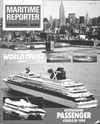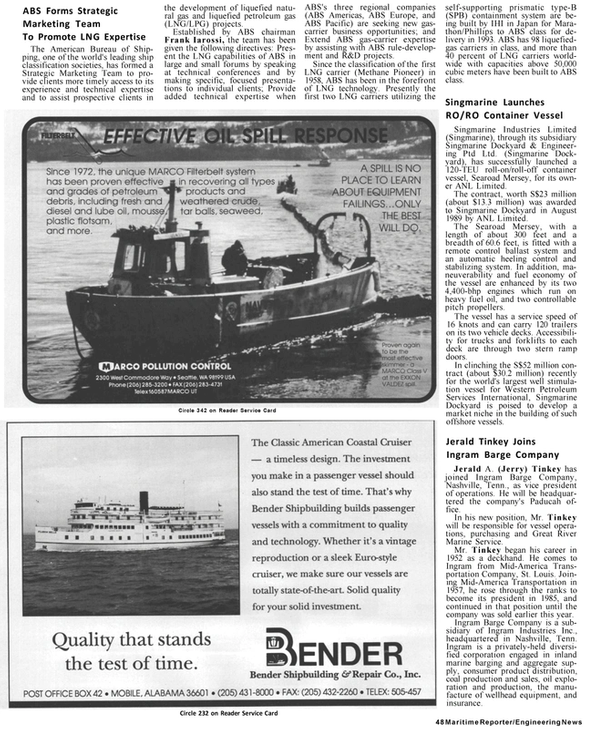
Former Leading U.S. Builder Becomes Leading U.S. Repairer
BMD Posts Successful Year; Eyes Retrofit Market Following a period of transition and consolidation of its marine operations, Bethlehem Steel Corporation, at one time one of the leading shipbuilders in the nation, has made a successful transformation into one of the leading U.S. full service ship repairers.
From August 1989, after a fourmonth strike was settled at the yard, to October 1990, Bethlehem Steel Corporation's Baltimore Marine Division (BMD), located at Sparrows Point, Md., drydocked a total of 28 commercial and governmental ships. Twenty-one of the vessels, composed of U.S.-flag and foreign-flag commercial, U.S. Navy, Military Sealift Command and Ready Reserve Force ships, were repaired during 1990.
In an interview with MARITIME REPORTER, BMD officials were particularly encouraged by the company's success in the cruise ship repair sector.
"We are one of the leading U.S.
yards in the cruise ship repair market," said James L. Joyce, BMD's ship repair sales manager.
"However, we're not looking for place or show. We're looking for first," he said.
NORSHIPCO, located in Norfolk, Va., with total ship-repair sales approaching $250 million in 1990, is generally considered the leading U.S. cruise ship repairer.
According to Mr. Joyce, the Bal- timore Marine Division already has firm bookings for drydocking four cruise ships for 1991 and eight tentative bookings as well. BMD plans to simultaneously drydock two cruise ships at the yard—one in its huge 1,200- by 200-foot basin and one in its 40,000-ton-lift-capacity floating drydock Bethpride.
During a tour of the yard, workers were observed performing repairs on the 47,000-gross ton Celebration, owned by Carnival Cruise Lines.
According to BMD's chief estimator Thomas J. Young, the project called for the replacement of 150,000 pounds of steel in 16 days.
The Celebration project follows closely on the heels of the recently completed work on the ITB Francis Hammer—160,000 pounds of steel replacement in 21 days.
Besides the Celebration, BMD was also preparing the USS Waterford (ARD-5), a Navy submarine drydock normally operating out of Groton, Conn., for a mid-December delivery. The Waterford was undergoing steel, pipe and valve renewals under an $8.7-million contract.
BMD was replacing steel on the operating platforms on both pontoon decks. The Waterford was docked in BMD's huge 1,200- by 200-foot basin, which can handle vessels as long as 1,200 feet and wide as 192 feet. A two-position intermediate gate can divide the basin's length into sections measuring 300 feet and 900 feet, or 685 feet and 515 feet. This gate increases the yard's flexibility for handling a variety of jobs simultaneously.
The yard also recently completed 300,000 pounds of steel replacement on the ITBs New York and Jacksonville.
While the volume of work at BMD has been very good for 1990, business has slowed as of late due to Operation Desert Shield.
"The initial effect of Operation Desert Shield was a flurry of activity in reactivating ships from the reserve fleet," said Mr. Joyce. "Now, however, government work is being delayed due to the uncertainties in budgeting for Operation Desert Shield. In addition, some commercial operators are deferring dockings in order to make their ships available for government charter," he said.
Despite their success in the shiprepair market, however, BMD officials were quick to emphasize the fact that they are not out of the vessel and barge new construction markets and are pursuing a number of tank barge and double-hull forebody tanker retrofit designs.
"We just completed the tests for a preliminary design of a 60,000-barrel tank barge and have plans for a 90,000-100,000-barrel design," said Karl E. Briers, BMD marketing manager. "We are also working on a double-hull forebody for two classes of tankers—one for a class built by Bethlehem Steel in the seventies.
The trick is trying to make the forebody an attractive option for the owner." According to Robert A. Fiorelli, BMD's manager of marketing, sales, planning and technical services, newbuilding double-hull tanker contracts spurred by the Oil Pollution Act of 1990 would probably start being awarded in 1992.
"Our facilities, as far as hull structure goes, are as good as any shipyard in this country. We are currently talking with two major operators about developing (tanker retrofit) designs," Mr. Fiorelli said. "We are interested in series construction and the multiple conversion market," he added.
Baltimore Marine Division's position was best summed up by Mr.
Briers who said, "We are positioning ourselves for the possibility of a sustained upturn in new construction.
We see that in the future for us." Perhaps another transition lies ahead for Bethlehem Steel's Baltimore Marine Division.
For free literature detailing the facilities of BMD, Circle 56 on Reader Service Card
Read Former Leading U.S. Builder Becomes Leading U.S. Repairer in Pdf, Flash or Html5 edition of January 1991 Maritime Reporter
Other stories from January 1991 issue
Content
- New Exxon Plant Provides Customer-Specific Product Blends For Marine Industry page: 8
- 1991 Ship Production Symposium Issues Call For Papers page: 8
- Thames Operator Buys High-Tech Catamarans page: 9
- World Merchant Fleet Continues To Expand page: 10
- Gerard Technology Offers New Generation Of Teamtec/Golar Incinerators page: 10
- First Of Four Parcel Tankers Being Built For Stolt Named At Kleven Floro Yard In Norway page: 11
- Mackay Communications Announces Key Promotions page: 11
- Fairbanks Morse Increases Service For Pielstick And Fairbanks Morse Engines page: 12
- More Foreign Nations Under FMC Investigation For Shipping Practices page: 12
- Captain Leback Honored At SUNY Maritime College page: 14
- Hopeman Bros. To Supply Joiner Systems For Viking Serenade Project page: 15
- Hatch & Kirk Offers Engine Control Panel page: 15
- U.S. Navy Secretary Participates In LCAC Trial page: 17
- BP Adds Cargo Controls To S/T Keystone Canyon page: 17
- High-Speed Innovative Containership To Be Designed By Japanese page: 18
- CRUISE SHIPPING '91 Conference & Exhibition page: 20
- 10 MILLION PASSENGERS PER YEAR BY 2000, ANALYSTS SAY page: 24
- VIS Introduces New Vessel Instrumentation And Alarm System page: 26
- Sea Recovery Provides Custom- Or Pre-Designed Reverse Osmosis Units page: 27
- Meyer Werft Delivers Eighth Passenger Ship For Indonesia page: 28
- Kvaerner Delivers New Flying Cat High-Speed Catamaran To Greece page: 29
- New Simrad Echo Sounder Goes Into Operation page: 29
- OUTSTANDING PASSENGER VESSELS OF 1990 page: 30
- Aluminum Boats Delivers 85-Foot Crewboat— Sixth Built For Land And Marine page: 42
- Deway Marine & Industrial Patents New Seal For In-Water Shaft Repair page: 43
- Former Leading U.S. Builder Becomes Leading U.S. Repairer page: 46
- National Association Of Passenger Vessel Owners Annual Convention And Exhibition page: 48
- ABS Forms Strategic Marketing Team To Promote LNG Expertise page: 50
- Singmarine Launches RO/RO Container Vessel page: 50
- Jerald Tinkey Joins Ingram Barge Company page: 50
- World's Largest Refrigerated Cargo Ship, Built By Danyard A/S, Enters Service —First Of Class— page: 52
- Seventeen Additional RRF Vessels Activated For Persian Gulf Crisis page: 53
- Harbor Dredging Begins To Pay Off page: 54
- Marathon LeTourneau Announces Organizational Changes page: 54
- Thordon's 'Thor-Lube' Bearing System Combines Improved Performance, Ecological Safety page: 55
- Underwater Propeller Polish Produces 12 Percent Fuel Saving For QE2 page: 56
- Swiftships Launches Detroit Diesel-Powered Custom Motoryacht page: 56
- Keel-Laying Ceremony For Double-Bottom Tanker Held At IHI's Aichi Yard page: 58
- Subtech '91 Issues Call For Papers page: 58
- Two Models Of Zodiac's Rigid Inflatable Boats (RIB) Chosen By U.S. Navy page: 59
- Furuno Again Honored At Annual NMEA Awards Banquet In Florida page: 59
- Tenth Maritime Seminar Set For New Orleans, January 10, 1991 page: 60
- Marine Training School To Use S/S Annabella As LNG/LPG Training Ship page: 60
- U.S. Merchant Fleet Development Urged By Shipping Executive At New Orleans Conference page: 60
- Goudy & Stevens Shipyard Integrates Automated Layout, Cutting Processes In Building Largest U.S. Oil Skimmer page: 61
- $8.13 Million Conversion Contract Awarded Keppel page: 61
- Great Lakes Dredge Buys Barker Boys Creek Towing page: 62
- IDB-A Joins Cruisephone To Offer Services To Leisure Markets page: 63
- EES Announces New Sewage Treatment System page: 63
- Spectra Composites Take Undersea Exploration To Greater Depths page: 64
- International Conference On Underwater Welding Set For New Orleans page: 64
- Aqua-Chem To Move To New Location In Milwaukee, Wis. page: 64
- Atlantic Marine Acquires Floating Drydock With 225,000-DWT Lift Capacity page: 65
- Aqua Signal Supplies Lighting Systems For Cruise Ships page: 65
- Port Facilities Engineering Seminar Set By AAPA For January 28-30, 1991 page: 66


